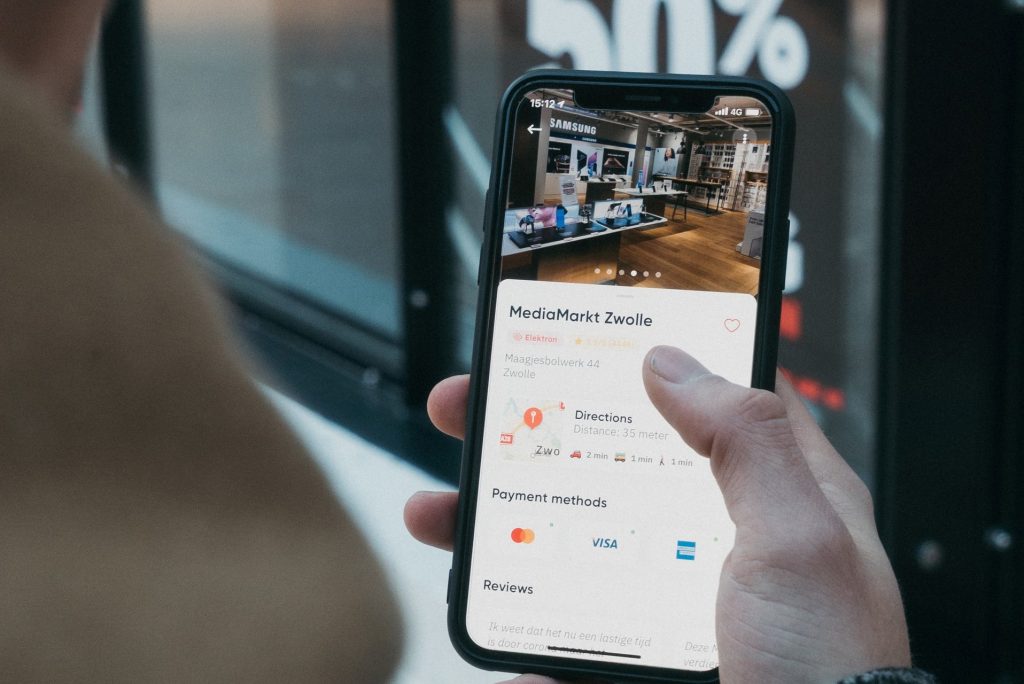What, Exactly, Is Geofencing? The Breakthrough Ad Technology, Explained

If you’ve been searching for advertising options for your business in the last few years, you’ve probably heard the term “geofencing” at least once, and probably much more. That’s because the popularity of geofencing has soared in recent years as marketers and business owners alike discover how effective it can be.
Before you begin a geofencing campaign yourself or hire an agency to help you, it’s good to know what, exactly, geofencing is, how it works, and what it can do for you.
What is geofencing, anyway?
Geofencing is the practice of selecting a specific location, creating a virtual “fence” around the location, and delivering ads to internet users who are inside the fenced area while excluding users who are outside of it.
Here’s what that looks like in a practical sense:
A business decides they want to advertise a flash sale at their store in the local mall. They geofence, or set up a radius, around that mall. Then, their advertising platforms like Facebook, Google, and YouTube, deliver ads to people who are using the internet inside that radius. Nobody outside of that radius receives the ad.
In addition, advertisers can combine geofencing with demographic targeting. So if the store in the example sells clothing for adult men, the advertiser can set their platforms to only deliver ads to males aged 18-55 who are inside the geofenced area. Filters based on criteria like income levels, marital status, and interests can also be applied. There is almost no limit to how granular it can get.
As a result, advertisers don’t need to waste money sending ads to people who are unlikely to spend money with that company. It also means that the people they do send the ads to have a much higher likelihood of spending money with that company than the general population.

How does geofencing work?
Geofencing uses a number of methods to establish people’s location and deliver advertisements.
Advertisers first need to set up accounts with the platforms they plan to use to deliver ads. There are several choices, but the most popular ones are Facebook, Google, and YouTube. On these platforms, users can select their demographic criteria and input their ad content. After that, they can select locations to target.
There are some differences between the platforms. For example, Facebook limits advertisers to a 1-mile radius as its most precise location targeting, while Google allows advertisers to get a little more specific. But for the most part, they work in very similar ways.
These platforms can recognize people’s locations in a few ways.
- Location services. When people allow their browser or other apps to track their location, this information can be sent to advertisers to let them know when they are in a geofenced area.
- Radio Frequency Identification. Known more commonly as RFID, this technology allows phones to communicate passively with other internet-connected devices and tags. If someone with RFID enabled on their phone passes by a reader, it can signal to advertisers that that person is inside the geofenced area.
- WiFi connections. Another common way of establishing an internet user’s location is by monitoring connections to WiFi. These technologies usually involve opt-ins, meaning users volunteer their data. As a result, advertisers can often scrape more data from these connections in addition to establishing a user’s location.
Advantages of Geofencing Technology
It wouldn’t be overstating it to say that geofencing technology has revolutionized marketing. As a technology, it has enabled entirely new ways for marketers to reach potential customers and make their campaigns more efficient and effective. That’s because geofencing offers several unique advantages.
Accuracy
By far the biggest advantage of geofencing advertising is accuracy. Being able to target very specific locations allows advertisers to target potential customers with surgical precision.
Before, advertisers could select specific cities or sometimes even zip codes. But that still meant a lot of wasted ad deliveries and as a result, dollars. With geotargeting, advertisers can select locations in which people are the most likely to find ads to be relevant to them. That means each dollar spent on advertising is more likely to generate an ROI than in broader location-based campaigns.
Transparency
Another major benefit of geofencing technology in advertising is the transparency it affords to the advertisers. That’s because the additional granularity of ad delivery brings back even more data than traditional digital advertising.
Using geofencing technology, an advertiser can see how users interacted with their ads in specific locations. If a company selling coffee mugs wanted to geofence several popular coffee shops in an area, they would be able to see which shops produced the highest engagement levels. Previously, advertisers would have been limited to much broader areas and would have to make more guesses and assumptions when analyzing the data.

Effectiveness
One reason business owners and advertisers have fallen in love with geofenced advertising is that it is more effective than traditional digital advertising. And not just a little effective. Entrepreneur magazine found that location-based digital ads were 20 times more effective than generic banner ads.
That’s entirely logical. As mentioned before, geofencing allows advertisers to select their potential customers with incredible precision. Done right, this means that only those who are most likely to engage will receive ads, resulting in high conversion and engagement rates.
Budget-Friendliness
You may think that cutting-edge advertising technology like this costs a small fortune. Certainly, there are many geofencing companies that don’t mind charging a premium for these services. But in many ways, geofenced advertising campaigns can and should be cheaper than other digital marketing campaigns.
The reason goes back to its accuracy and effectiveness. In more traditional models, advertisers pay to send ads to a lot of people who are very unlikely to engage with them. Until recently, that’s just been the cost of doing business.
But run correctly, advertisers using geofencing only need to pay to send ads to people with a high probability of engaging with them. That means a much higher probability of an ROI and fewer wasted ad deliveries.
In addition, with no minimum ad spend, digital advertising has no real financial barrier to entry. Even on very limited budgets, companies can generate significant results.
Types of Geofence Marketing Campaigns
Another huge advantage of geofencing marketing is that it opens up a lot of different strategy options. Companies using geofencing can run their campaigns in a number of different ways. Here are just a few examples.
Urgency and Opportunity Campaigns
One popular form of geofencing marketing takes advantage of a user’s proximity to a business. As an example, let’s say an ice cream shop shares a shopping center with a busy coffee shop. The ice cream shop can geofence that coffee shop and send ads to people inside the area promoting a limited time only flavor, or talking about how nice an ice cream cone is on a very hot day, weather permitting.
This kind of messaging can inspire urgency among customers, giving them the sense that not only is a product nearby but that they also have a limited opportunity to get that product.
Companion Business Campaigns
Every business has other businesses that share a similar customer base. Gyms and health food stores, for example, will have a lot of overlap in customers. Hotels and car rental agencies also share many of their customers.
Companion businesses can serve as a kind of shortcut to creating a well-defined target audience. Advertisers can select a business that shares a customer base to geofence, then push ads to internet users while they are inside or near the business.
Advertisers can even take it a step further, involving the business in their ads if they want. They can do this with messaging (“Like Bob’s Smoothies? Then you’ll love Greg’s Gym”), or even by offering collaborating directly with the companion business to offer coupons or discounts in the ads.
Competitor Challenge Campaigns
Just as every business has companion businesses, they also have competitors. While some strategies work around the competition, creating a competitor campaign tackles the competition head-on.
In a competitor campaign, a company can geofence a competitor’s business and tout the superiority of their product or service. This works because like companion businesses, a competitor shares much of the same customer base.
Often, advertisers will use human behavior to their advantage. For example, an advertiser for a packaging and shipping store knows that people at the post office will spend time waiting in line and that this can be frustrating. They also know that when people wait in line, they often use their phones.
Knowing this, they might deliver ads that incorporate that situation into their messaging. People browsing the internet on their phone while waiting in line may see an ad that says something like, “Got somewhere to be? Skip the line at ABC Package Express!”

Geofencing drives real traffic, not just clicks, to your business.
One of the downsides of digital marketing is that too often, advertising exists for itself. The introduction of CPAs, CPCs, VTRs and others has caused some advertisers to focus on these metrics and lose sight of the main objective: driving business traffic. No matter how many clicks an ad gets, it doesn’t mean anything until those clicks translate into revenue.
That’s partly because precise ad targeting means that people are more likely to want to spend money with the company that delivers ads. In a traditional campaign with broad targeting, it’s more of a numbers game. Ads are sent out en masse to people who may or may not actually be interested in a business. To make matters worse, many people click on ads out of curiosity with no real intention to buy anything, costing the advertiser money each and every time without much hope for an ROI.
But there’s more to it than that. Recently, advertisers have found more ways to use geofencing to inspire actual foot traffic to physical locations. One way is the aforementioned urgency and opportunity campaign. These campaigns take advantage of an internet user’s actual proximity to a physical location, making it easy and attractive for them to stop by.
Taking things even further, many companies have found ways to use geofencing to integrate their in-person and online experiences, building brand familiarity and loyalty while doing so.
Retailers, for example, can geofence nearby locations and push ads about in-store promotions or events. After making a purchase, a customer can receive ads that motivate them to check out the company’s deals online. Retailers can even offer email receipts to prompt the customer to open their phone. As a result, they can create a cycle of sending traffic back and forth between their website or social media account and their physical location.
How much does geofencing advertising cost?
Here’s the answer nobody wants to this question: it depends. But there are two aspects to consider when it comes to calculating the cost of geofencing.
The first is the cost of delivering the ads themselves. And for that, there isn’t just one answer. Truthfully, this ad budget can be as little or as much as you want. There is no minimum ad spend for digital advertising and no real maximum either. That means it’s the business or advertisers themselves that determine this cost.
However, the amount you spend can have a dramatic impact on how much traffic your campaigns generate. In general, more spending means more traffic—but only up to a point. After some point, you’ll start to see diminishing returns on your investment as you begin to saturate your market.
In general, companies should look to spend at least a few hundred dollars a month on geofenced advertising and preferably more. Some companies spend tens of thousands of dollars per month on location-based ads. It really depends on the budget, the size of the target audience, and the business’ marketing goals.
The other cost to consider is the cost of a service provider if you choose to use one. It is certainly possible to conduct DIY geofencing campaigns. Many people do and are happy with the results.
Part of the reason many small business owners choose to go the DIY route is that, until recently, most geotargeting companies focused their attention on large national brands with large budgets to match. For many, these services were just too expensive or, in some cases, not even available to them.
But now, companies that specialize in conducting location-based advertising campaigns for small businesses have begun to emerge. GeoTarget, for example, offers a number of packages geared towards the small business budget, starting at just a few hundred dollars per month.
Unless you’re a trained digital marketing professional, these services are well worth the investment. That’s because while a well-run targeting campaign can really benefit your business, a bad targeting campaign can be a real money pit. One study found that as much as 65% of media spending on location-based ads was wasted on bad targeting.
For many, the cost of these wasted ads far exceeds the cost of professional location-based marketing services companies like GeoTarget provide. That’s not even considering the cost of spending your own time running campaigns.

Here’s why geofencing should be a part of any business’s marketing strategy.
Geofencing offers so many advantages to businesses of almost any industry that it should be considered a staple of their marketing strategy—as much as a social media account or an email list. For many businesses, it already is, even though the technology is relatively new.
From 2016 to 2020, spending on targeted mobile advertising more than doubled, from $12.4 billion to $27.2 million. Researchers project that that number will rise to $32.7 million by 2023. It’s abundantly clear that more businesses are starting to understand the power of geofencing advertising.
Geofencing marketing is also well within reach for many businesses due to its low cost of entry. While other forms of local marketing like billboards or mailers require a substantial investment up front, you can start a geotargeted marketing campaign with whatever you can afford to spend.
And once you do, these campaigns scale easily. A good professional can help you establish an accurate Cost Per Acquisition (CPA). This is essentially the estimated cost of using an advertisement to get a customer to make a purchase. Once you know this, you can forecast the ROI at different levels of spending with relative accuracy.
All of this means that your advertising decisions are easier than ever. Traditional forms of advertising and even generic digital advertising are much more of a guessing game. But geofencing marketing offers clarity and transparency on how ads are performing and what it costs to acquire new business.
But beyond all the numbers and advertising jargon lies a much deeper reason to use location-based marketing: it helps business owners build connections with their community. By focusing on building name recognition for people who live, work, and play in their local community, businesses can establish themselves as friendly neighborhood providers of goods and/or services.
That kind of brand affinity is the crown jewel of marketing—establishing a business and the people who operate it and work there as a place that people have real emotional connections to. With a well-run campaign, you can go from a business to a beloved member of your community.
Ready to harness the power of geofenced advertising for your small local business? We are.



